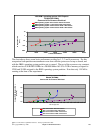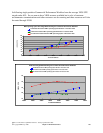
14.6 IBM i operating system 5.4 Virtual SCSI Performance
The primary goal of virtualization is to lower the total cost of ownership of equipment by
improving utilization of the overall system resources and reducing the labor requirements to
operate and manage many servers.
With virtualization, the IBM Power Systems can now be used similar to the way mainframes
have been used for decades, sharing the hardware between many programs, services,
applications, or users. Of course, for each of these individual users of the hardware, sharing
resources may result in lower performance than having dedicated hardware, but the overall cost
is usually far less than when dedicating hardware to each user. The decision of using
virtualization is therefore a trade-off between cost and performance.
IBM i operating system Virtual SCSI is based on a client/server relationship. A IBM i operating
system Server partition owns the physical resources, and client partitions access the virtual SCSI
resources provided by the IBM i operating system Server partition. The IBM i operating system
Server partition has physically attached I/O devices and exports one or more of these devices to
other partitions. The client partition is a partition that has a virtual disk and relies on the IBM i
operating system Server partition to provide access to one or more physical devices. POWER5
and future POWER technologies provide virtual SCSI support for AIX 5L V5.3 and Linux.
Previous POWER technology supported Linux virtual SCSI.
The performance considerations that we detail in this section must be balanced against the
savings made on the overall system cost. For example, the smallest physical disk that is available
to the IBM i operating system is 70 GB. An AIX or Linux operating system requires only 4 GB
of disk. If one disk is dedicated to the operating system, nearly 95% of this physical disk space is
unused. Furthermore, the system disk I/O rate is often very low. With the help of IBM i
operating system Virtual SCSI, it is possible to split the same disk into 9 virtual disks of about
8 GB each. If each of these disks is used for installation of the operating system, you can support
nine separate instances of the operating system, with nine times fewer disks and perhaps as many
physical SCSI adapters. Compare these savings with the extra cost of processing power needed
to handle the virtual disks.
Enabling IBM i operating system Virtual SCSI results in using extra processing power compared
to directly attached disks, due to extra POWER VIO activity. Depending on the configuration,
this may or may not yield the same performance when comparing virtual hosted disk devices to
physically attached SCSI devices. If a partition has high performance and disk I/O requirements
that justify the cost of dedicated hardware, then using virtual SCSI is not recommended.
However, partitions with non-critical performance and low disk I/O requirements often can be
configured to use virtual SCSI, which in turn lowers hardware and operating costs.
IBM i 6.1 Performance Capabilities Reference - January/April/October 2008
© Copyright IBM Corp. 2008 Chapter 14 DASD Performance 231


















